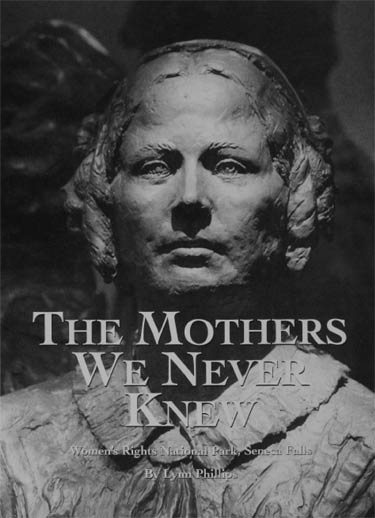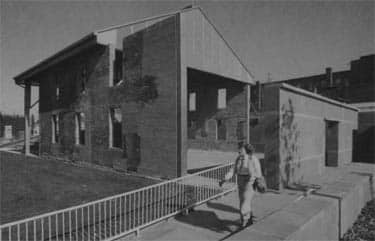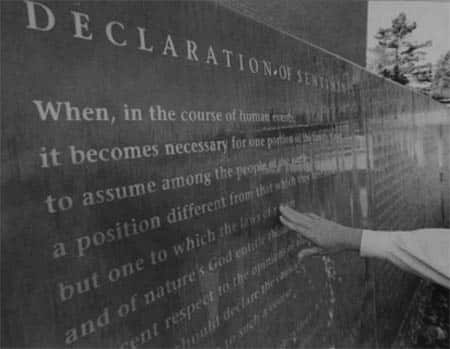by Lynn Phillips
We’re supposed to revere our feminist foremothers, but most of us don’t. One friend of mine describes the creators of American feminism as a bunch of “graham crackers – teetotaling, middle class goody-goodies on fad diets.” I can’t argue. Personally, I’d prefer foremothers with more screen presence, foremothers with killer haircuts like Jeanne d’Arc, or with attitude, like Madame Defarge. But, alas, you cannot choose your political foremothers any more than you can choose your own mother; all you can do is to Come To Terms with them. And the sooner you do it the better.

Seneca Falls, birthplace of American Feminism, is a good place to begin romancing our origins. It was here, in the once thriving mill town in upper New York state that the housewife-intellectual Elizabeth Cady (Rodham!) Stanton, the abolitionist preacher Lucretia Mott and a klatch of local ladies organized the first Women’s Rights Convention in world history, back in 1848.
1993 was a good time to go to Seneca Falls. A minimal version of a “Women’s Rights National Park has been operated here by the National Park Service since 1980. Now, 145 years after the Women’s Rights Convention, the Park Service has expanded the park to include a $12 million “Wesleyan Chapel Block,” which includes the Methodist chapel where the Convention was held, a new visitors center and a fountain. Nearby, you can tour foremothers’ homes (including that of organizer and agitator Susan B. Anthony in Rochester, 40 miles to the west). You can peruse various historical attractions and visit the Women’s Hall of Fame. Somewhere in that welter of totems (I hoped) my Coming To Terms would begin.
Footless beginnings
My pilgrimage got off on a lame foot. Of those who attended the Seneca Falls convention the only one with real heft, foremother-wise, was Elizabeth Cady Stanton. It was she who drew up the Declaration of Sentiments that served as the new movement’s manifesto, and because she did it at a local tea party, it’s supposed to show how anyone here in America can start her own social revolution. Reading up on Cady Stanton, however, I realized that although she was more delectably outrageous than I’d remembered, when push came to shove she devolved from active abolitionist into insufferable racist.
It happened after the Civil War. When drafting the Fourteenth Amendment to enfranchise ex-slaves, Republican legislators – Cady Stanton’s past allies – refused to enfranchise women as well. They also inserted the word “male” into voting law for the first time. (Until then maleness was assumed but not spelled out.) Even black abolitionist Frederick Douglass – who’d backed the women’s rights movement at its inception – now defended the amendment s explicitly sexist wording.
In reaction, Cady Stanton and Susan B. Anthony (who’d become Cady Stanton’s right hand) sank well below their betrayers’ level. They first opposed the Fourteenth Amendment entirely, then, convinced it would pass, hooked up with Francis Train, a Dixie demagogue-wannabe, wealthy populist and blatant racist. The Train team toured the country urging men to support the women’s vote because women’s ballots would offset the votes of ignorant Sambos. The affair split the women’s movement. Worse, it left us a legacy of reciprocal mistrust between white women and blacks – a legacy too repulsive and destructive to forgive.
The past lives
The Women’s Rights National Park turned out to be a fine place to wrestle such serpents. To begin with, the ground floor of the new visitors’ center boasts a bronze sculpture that lets you mingle in a crowd of life-sized Convention attendees. Here, you can thank Frederick Douglass for his early support without having to cope with his later defection. Here, you can hug the brilliant Cady Stanton of the 1840s without having to embrace the bigot of the 1860s.
Furthermore, Park Service women have fought – successfully – to make the park a monument to a controversial, vital social movement, not just a shrine to a buried one. On the visitors’ centers second floor is a clamor of snappy placards and interactive exhibits exploring how our current struggle for equality builds on and revises our past.

Outside, the theme of continual rebirth is subtly articulated by architects Ann Wills Marshall and Ray Kinoshita, in their refiguring of the Wesleyan Chapel’s remains. Because the chapel had fallen into such neglect – it was last a laundromat – they could reclaim only two walls to support the original hand-hewn roof timbers. The resulting structure appears at once half-destroyed and half unfinished – an emblem of the movement our foremothers founded.
Steel magnolias?
Beyond the resurrected ruin of the chapel, at the foot of a tidy grass slope designed for today’s assemblies, is the 140 foot fountain. There you learn more about our movement’s birth. Seneca Falls’ new waterfall slashes smoothly over bluestone slabs onto a strip of cobbles. At the water-wall’s end, the Convention’s Declaration of Sentiments are set in letters of steel. The document, adopted at the original convention by about a third of the 300 men and women present, was modeled daringly on the Declaration of Independence: “We declare these truths to be self evident,” it proclaims, “that all men and women are created equal….”
Reading the Declaration through the fountain’s veil of tears I noted with embarrassment that what begins as a warlike cry to “overthrow tyranny” ends in a wussy whisper. Rather than rising up in a ululating mass to strangle resistant legislators in their beds, the ladies of Seneca Falls threaten only to “endeavor to enlist the pulpit and the press on our behalf.” They rattled their chains, these foremotherly ghosts, but not their swords.
A closer reading of the Declaration shows they really had no swords to rattle. The text reveals that wives of that period had no right to own or inherit property. Even their wages, if they had any, were legally their husbands’ to squander. Without money or votes, inexperienced in worldly affairs, bound by ties of blood and love, our foremothers were totally dependent on their adversaries.
Despite the Declaration’s mixed message, it illuminates Cady Stanton’s greatness. In detailing women’s oppression she took aim not only at their disenfranchisement, but at society’s double standards of morality and women’s economic dependency, at inequities in education, opportunity, marriage and divorce law. She even denounced the way men appropriate the authority of religion to rob women of self-esteem. If breadth of vision could kill, Pow! Bang!, she’d be our howitzer.
Paying our respects
After reading the Declaration through, I was feeling sufficiently respectful to pay Cady Stanton a personal call. Her house was a little over half a mile from the chapel. There, a avid ranger named Fish led a tour from room to room, showing Cady Stanton’s dinnerware (“a simpler design than was common at the time”), recounting what day she did her laundry (I forget), and pointing out that she did not force her husband and seven children to share her sawdusty, high fibre, low-fat, graham diet. No, indeed. She clogged their arteries with goose fat while babying her digestive tract with “pie crust made without shortening.” Why did I suddenly find her so adorable?

Visiting Cady Stanton’s home brought home to me that our foremothers’ struggles can never be an epic movie; their dramas are too private, too intimate to play out on the big screen. Their vehicle is the novel and – I should have known from earlier reading – the plotline of Cady Stanton’s was a story about a girl and her dad long before it was a tale of struggle over inheritance law and suffrage. All his life Judge Cady refused to love his daughter Elizabeth as he would a son. None of the Latin, Greek and mathematics she mastered, no accomplishment she offered up could change his mind. Her rage and despair over his locked heart was the juice that powered her nothing-left-to-lose attack on every sacred cow of her time. (The same childlike fury fed her race-baiting, and while her reactive tantrum remains unforgivable, understanding her better let me – emotionally – come to terms with her flaws).
Making it all worthwhile
The night the new visitor’s center opened in Seneca Falls, Augie Sinicropi, a native son who’d valiantly drummed up support for the Women’s Rights park from the local business community, got a standing ovation when he said: “I worked for this park for one reason: I didn’t want my daughters to suffer any discrimination my sons don’t face.”
His speech brought down the house because it tacitly acknowledged the power of feminism – a movement that has so often seemed a fractious and divisive force – to renegotiate intimacy, to bring families and individuals together with pride, joy and love where before we felt only frustration and estrangement.
I am naturally pleased that so many of the obstacles women faced in Elizabeth Cady Stanton’s day have been whittled down by the movement that was born of her longing. But when I think of what it would have meant to her to hear Sinicropi’s words from her own father’s lips, I am truly moved. For a young girl to be able to aim as high as she likes in life without losing her father’s love is a victory no smaller than the banishment of kings. I can finally start to see our movie – and it’s a woman’s picture.
Lynn Phillips is editorial page and op-ed editor for Her New York, a weekly tabloid far women.
